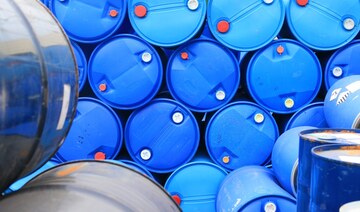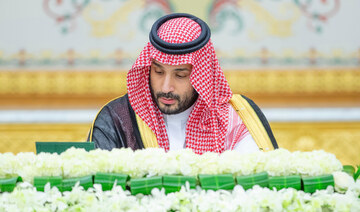RIYADH: Moody’s Investors Service has retained a positive outlook for Saudi Arabia’s banking sector thanks to the Kingdom’s economic diversification programs.
In its latest report, the US-based credit rating agency said the demand for credit for government-backed projects will improve loan performance and generate strong profit for banks in Saudi Arabia.
“The banks’ operating environment will continue to be supported by the strong momentum in the non-oil sector, which will benefit from the accelerated implementation of the economic diversification agenda,” said Moody’s.
The report added that expected interest rate cycle reversal could squeeze margins, although loan growth and lesser funding costs could soften the impact of lower rates.
Moody’s, however, noted that the Kingdom’s financial institutions’ high reliance on government deposits and increased market funding on the back of high credit growth will remain a source of risk.
“Our positive outlook also captures the government’s strengthening capacity to support banks. Heightened geopolitical tensions or much lower oil prices remain risks,” it added.
Giga-projects to drive corporate credits for banks
According to Moody’s, the ongoing giga-projects in Saudi Arabia backed by the Public Investment Fund will drive growth for corporate credit, while residential mortgages will remain the main contributor to credit demand on the consumer side.
Other factors that could lead to the positive performance of banks in Saudi Arabia entail the creation of new sectors in the Kingdom which includes non-religious tourism and the entertainment industry.
“Faster implementation of Saudi Arabia’s Vision 2030 economic diversification projects is the top priority for government expenditure in 2024, which is likely to exceed 2023 budgeted expenditure by 13 percent and will likely remain high over the next few years. The strong momentum in the non-oil sectors is set to continue in 2024 and we expect growth to exceed 5 percent,” said the credit rating agency.
Loan quality to improve
Moody’s pointed out that lending to low-risk government-backed projects will support Saudi banks’ asset quality.
The credit rating agency added that rising exposure to residential mortgages where most borrowers are government employees with secure jobs provides additional support and lowers concentration risk.
The report predicted that non-performing loans are expected to stand at around 1.5 percent of gross loans, supported by high borrower quality and fast credit growth.
In its report, Moody’s underscored that banks operating in Saudi Arabia have sizable loss-absorption capacity and their capital ratios are among the highest in the Middle East region.
The credit rating agency pointed out that the loss-absorption capacity of these financial institutions is further supported by high loan loss reserves, which exceed 100 percent of the existing stock of NPLs.
Saudi banks to witness strong profitability
According to the report, the net income of banks in Saudi Arabia is expected to stabilize at 1.7 percent of tangible banking assets in 2024 after recovering well from 1.4 percent during the pandemic in 2020 to reach 1.9 percent as of September 2023, driven by higher rates and fast loan growth.
“Expanding loan books will still support Saudi banks’ profits. But margins could come under pressure as the rates cycle reverses course. This is because earnings on corporate-loan portfolios will be lower, with most repricing on a quarterly basis,” said Moody’s.
It added: “Funding pressures in the system due to faster loan growth than deposits have pushed funding cost more than four folds since 2020. We expect loan-loss provisioning costs to remain low and Saudi banks to maintain sound cost controls and high efficiency.”
Contrary to the past, banks in Saudi Arabia which usually source most of their funding from deposits are expected to rely slightly more on market funding over the next 12 to 18 months as credit demand remains strong.
The report added that the reliance of these financial institutions on deposits from government and government-related bodies will continue to expand in the coming months.
On a positive note, Moody’s noted that the capacity of the Saudi government to support failing banks is strengthening.
“We assume a high or very high likelihood of government support for banks in the event of a bank failure. This is based on the government’s track record of timely intervention. The positive outlook on the government’s rating indicates its capacity to support the banks in times of stress will potentially increase,” said Moody’s.
In its report, the credit rating agency assigned a positive outlook to major banks in the Kingdom which includes Saudi National Bank, Riyad Bank, Saudi Awwal Bank, as well as, Banque Saudi Fransi, Alinma Bank, and Bank AlJazira.
Other banks in Saudi Arabia which received a positive outlook are the Arab National Bank, Saudi Investment Bank, and Gulf International Bank.
Out of the 11 commercial banks rated by Moody’s, the only financial institution on the list that received a stable outlook was AlRajhi Bank.
Meanwhile, in another report, Moody’s upgraded the outlook of the banking sector in the UAE from stable to positive, driven by the growth of the non-oil economy and rising business confidence in the emirates.
The credit rating agency added that the probability of the UAE government supporting the banks that fail to perform is high.
“We expect the UAE government’s willingness and capacity to support UAE banks to remain very high, underpinned by local banks’ dominance in the domestic financial system, the banking system’s concentrated structure, and the heavy footprint of the UAE government in most banks’ balance sheets,” said Moody’s.
It added: “The government of the UAE has a proven track record of supporting banks in times of stress. Finally, the government’s capacity to provide support will also remain very strong, as indicated by its credit rating.”
The credit rating agency revealed that the outlook of the banking sector in other countries in the Gulf Cooperation Council region including Bahrain, Kuwait, Oman, and Qatar remains stable.



























